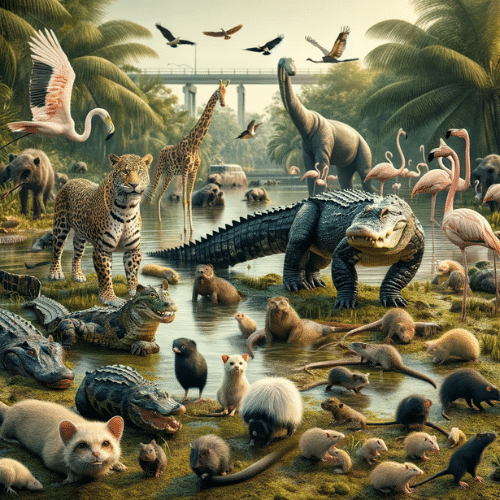
16 Jan Identifying Wildlife Threats
Confronting Wildlife Encounters
Welcome to our comprehensive guide on dealing with wildlife intrusions in South Florida. This article takes you on a journey through the diverse wildlife inhabiting our region. We address the challenges faced by South Florida residents, including homeowners, renters, and business owners, when dealing with these wild intruders. We leverage the experience of professional pest control experts who have battled wildlife intrusions for years to provide you with valuable insights.
South Florida boasts a stunning array of wildlife, from majestic birds to elusive mammals. To safeguard your property, you must first understand the species you might encounter. This knowledge serves as your first line of defense against wildlife intrusions.
When it comes to wildlife encounters, health and safety are paramount. We delve into potential health risks and offer insights into minimizing hazards. Whether it’s diseases carried by raccoons or allergens present in bird droppings, you’ll gain an understanding of the potential risks.
Our guide explores wildlife prevention strategies in detail, offering practical tips. From securing trash and food sources to sealing entry points, you’ll discover effective methods to deter wildlife intrusions. We also emphasize the importance of proper landscaping practices in discouraging wildlife.
Community involvement plays a crucial role in wildlife prevention. Coordinated efforts among neighbors in managing trash and conducting property inspections can significantly reduce wild intruders’ presence. Cooperation among residents can make a substantial difference.
Recognizing when to seek professional help is vital for managing wildlife intrusions effectively. Expert intervention can be a game-changer when dealing with advanced infestations or challenging species. We outline the benefits of involving professional pest controllers and share real-life situations where their expertise proved invaluable.
Wildlife in Your Space
Our tropical paradise attracts colorful birds like the Roseate Spoonbill and Painted Bunting. While these avian visitors enhance our surroundings, they may choose inconvenient nesting locations, such as vents or chimneys, leading to observable nests and chirping sounds.
Squirrels, both gray and fox varieties, are known for their acrobatics and knack for accessing secure bird feeders. Mysteriously disappearing birdseed or strange attic noises could indicate their presence.
Raccoons, clever and capable of causing property damage, often rummage through trash cans for food. Securing your garbage cans with tight-fitting lids can deter these masked marauders.
Early recognition of wildlife presence is crucial for effective management. Look for indicators like animal tracks and droppings, or listen for unusual sounds and odors. Wildlife can inflict damage on your home and yard, making regular property inspections essential.
We once received a call from a homeowner describing relentless attic noises. Investigation revealed a family of squirrels that had chewed through wiring and insulation, causing extensive damage.
Health Risks and Safety
Wildlife encounters can expose individuals to health risks, including disease transmission through bites or contact with bodily fluids. Prioritize caution and safety, especially with potentially dangerous species. Avoid direct contact with wildlife and their waste.
Various wildlife species serve as disease carriers, with raccoons as vectors for rabies and certain bird species harboring avian flu viruses. To minimize disease transmission risks, it’s crucial to avoid direct contact.
Wildlife droppings and urine can contain allergens and pathogens, potentially triggering allergies or respiratory problems. When cleaning up after wildlife intrusions, take precautions and wear protective gear if necessary.
Proactive Measures
Effectively preventing wildlife encounters requires a proactive approach. Implement these strategies to safeguard your property:
- Secure Trash and Food Sources: Raccoons and rodents are attracted to easily accessible food sources. Employ tight-fitting lids on garbage cans and store pet food indoors. Ensure bird feeders are squirrel-proof or placed away from your home.
- Seal Entry Points: Conduct a thorough property inspection to identify potential entry points, such as gaps in siding or loose shingles. Seal openings to prevent wildlife access, using materials like steel wool or caulk that animals struggle to chew through.
- Proper Landscaping Practices: Maintain your yard to discourage wildlife intrusion. Trim overhanging branches and keep trees and shrubs near your home well-trimmed to eliminate potential hiding spots.
- A Community Effort: Engage neighbors in coordinated trash management and property inspections. Collective community efforts can significantly impact wildlife populations.
Professional Help
While DIY measures can be effective, some situations require professional pest control experts’ expertise. Signs of a severe infestation, like frequent droppings, persistent noises, or visible nests, necessitate expert assistance. Wildlife populations can rapidly multiply, emphasizing the need for early intervention.
Professional pest controllers possess the knowledge, tools, and experience to safely and effectively address severe infestations. They can identify and seal hidden entry points, ensuring a comprehensive resolution. Seeking professional help ensures successful wildlife intrusion management.
In a case, a homeowner attempted to handle a raccoon intrusion but discovered multiple entry points. Our team identified and sealed these points, preventing further intrusions.
Conclusion
In conclusion, our comprehensive guide provides insights into wildlife intrusions in South Florida. From the diverse wildlife in our region to potential health risks and prevention strategies, we’ve equipped you to confront these challenges responsibly. Harmonious coexistence with wildlife is attainable through vigilance and timely action. While DIY measures have their place, professional help can be a crucial resource when needed. With knowledge and cooperation, you can peacefully coexist with South Florida’s captivating wildlife.


No Comments